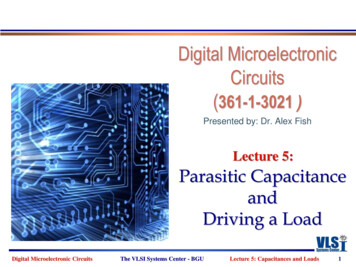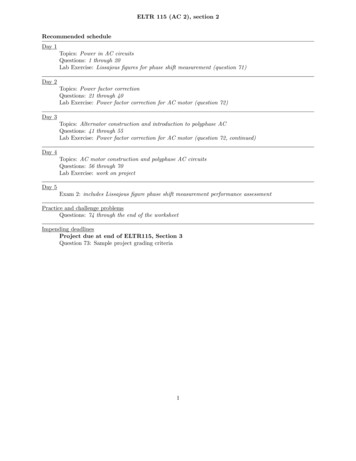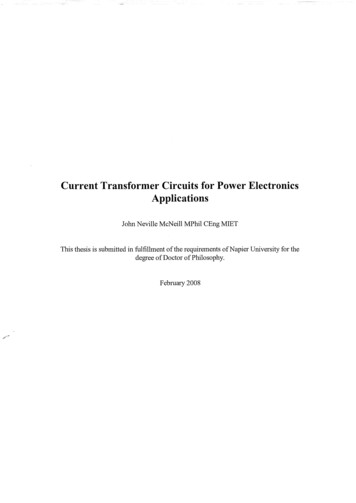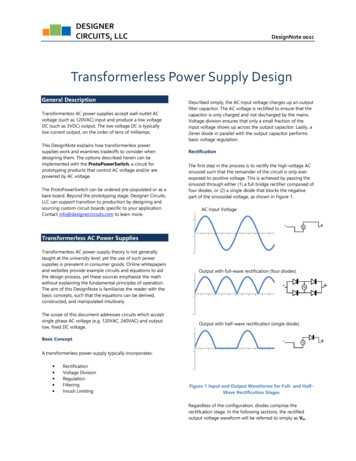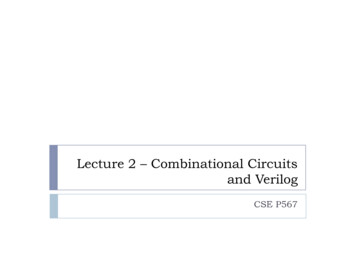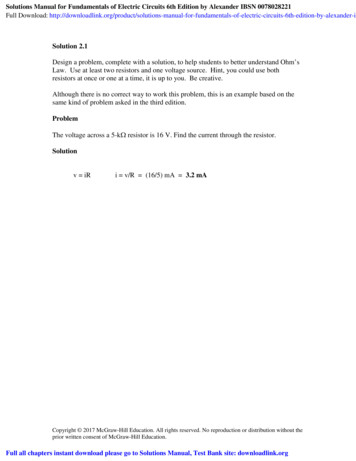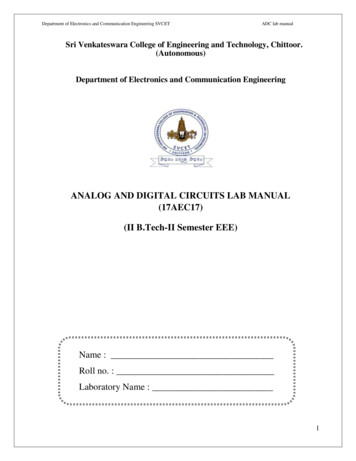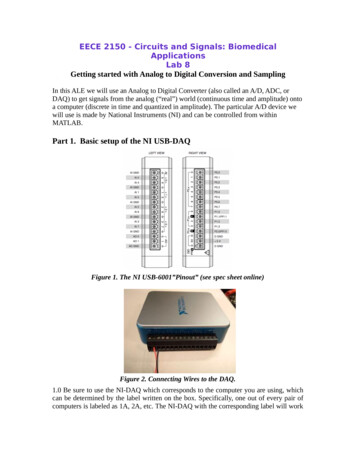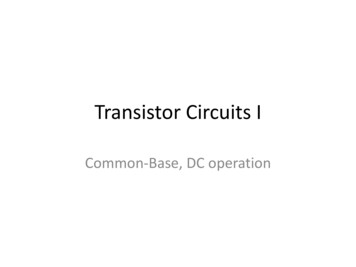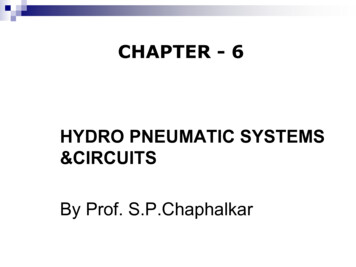
Transcription
MicroelectronicCircuitsSedra FM BM.indd 19/30/2014 9:36:10 PM
THE OXFORD SERIES IN ELECTRICAL AND COMPUTER ENGINEERINGAdel S. Sedra, Series EditorAllen and Holberg, CMOS Analog Circuit Design, 3rd editionBobrow, Elementary Linear Circuit Analysis, 2nd editionBobrow, Fundamentals of Electrical Engineering, 2nd editionCampbell, Fabrication Engineering at the Micro- and Nanoscale, 4th editionChen, Digital Signal ProcessingChen, Linear System Theory and Design, 4th editionChen, Signals and Systems, 3rd editionComer, Digital Logic and State Machine Design, 3rd editionComer, Microprocessor-Based System DesignCooper and McGillem, Probabilistic Methods of Signal and System Analysis, 3rd editionDimitrijev, Principles of Semiconductor Device, 2nd editionDimitrijev, Understanding Semiconductor DevicesFortney, Principles of Electronics: Analog & DigitalFranco, Electric Circuits FundamentalsGhausi, Electronic Devices and Circuits: Discrete and IntegratedGuru and Hiziroğlu, Electric Machinery and Transformers, 3rd editionHouts, Signal Analysis in Linear SystemsJones, Introduction to Optical Fiber Communication SystemsKrein, Elements of Power ElectronicsKuo, Digital Control Systems, 2nd editionLathi, Linear Systems and Signals, 2nd editionLathi and Ding, Modern Digital and Analog Communication Systems, 4th editionLathi, Signal Processing and Linear SystemsMartin, Digital Integrated Circuit DesignMiner, Lines and Electromagnetic Fields for EngineersParhami, Computer ArchitectureParhami, Computer Arithmetic, 2nd editionRoberts and Sedra, SPICE, 2nd editionRoberts, Taenzler, and Burns, An Introduction to Mixed-Signal IC Test and Measurement,2nd editionRoulston, An Introduction to the Physics of Semiconductor DevicesSadiku, Elements of Electromagnetics, 6th editionSantina, Stubberud, and Hostetter, Digital Control System Design, 2nd editionSarma, Introduction to Electrical EngineeringSchaumann, Xiao, and Van Valkenburg, Design of Analog Filters, 3rd editionSchwarz and Oldham, Electrical Engineering: An Introduction, 2nd editionSedra and Smith, Microelectronic Circuits, 7th editionStefani, Shahian, Savant, and Hostetter, Design of Feedback Control Systems, 4th editionTsividis/McAndrew, Operation and Modeling of the MOS Transistor, 3rd editionVan Valkenburg, Analog Filter DesignWarner and Grung, Semiconductor Device ElectronicsWolovich, Automatic Control SystemsYariv and Yeh, Photonics: Optical Electronics in Modern Communications, 6th editionŻak, Systems and ControlSedra FM BM.indd 29/30/2014 9:36:22 PM
SEVENTH EDITIONMicroelectronicCircuitsAdel S. SedraUniversity of WaterlooKenneth C. SmithUniversity of TorontoNew YorkOxfordOXFORD UNIVERSITY PRESSSedra FM BM.indd 39/30/2014 9:36:34 PM
Oxford University Press is a department of the University of Oxford. It furthers the University’s objective of excellence in research, scholarship, and education by publishing worldwide.Oxford New YorkAuckland Cape Town Dar es Salaam Hong Kong KarachiKuala Lumpur Madrid Melbourne Mexico City NairobiNew Delhi Shanghai Taipei TorontoWith offices inArgentina Austria Brazil Chile Czech Republic France GreeceGuatemala Hungary Italy Japan Poland Portugal SingaporeSouth Korea Switzerland Thailand Turkey Ukraine VietnamCopyright 2015, 2010, 2004, 1998 by Oxford University Press;1991, 1987 Holt, Rinehart, and Winston, Inc.; 1982 CBS College PublishingFor titles covered by Section 112 of the US Higher EducationOpportunity Act, please visit www.oup.com/us/he for thelatest information about pricing and alternate formats.Published in the United States of America byOxford University Press198 Madison Avenue, New York, NY 10016http://www.oup.comOxford is a registered trade mark of Oxford University Press.All rights reserved. No part of this publication may be reproduced,stored in a retrieval system, or transmitted, in any form or by any means,electronic, mechanical, photocopying, recording, or otherwise,without the prior permission of Oxford University Press.Library of Congress Cataloging-in-Publication DataSedra, Adel S., author.Microelectronic circuits / Adel S. Sedra, University of Waterloo, Kenneth C. Smith,University of Toronto. — Seventh edition.pages cm. — (The Oxford series in electrical and computer engineering)Includes bibliographical references and index.ISBN 978–0–19–933913–61. Electronic circuits. 2. Integrated circuits. I. Smith,Kenneth C. (Kenneth Carless), author. II. Title.TK7867.S39 2014621.3815—dc23 2014033965Multisim and National Instruments are trademarks of National Instruments. The Sedra/Smith,Microelectronic Circuits, Seventh Edition book is a product of Oxford University Press, not NationalInstruments Corporation or any of its affiliated companies, and Oxford University Press is solely responsible for the Sedra/Smith book and its content. Neither Oxford University Press, the Sedra/Smith book, norany of the books and other goods and services offered by Oxford University Press are official publicationsof National Instruments Corporation or any of its affiliated companies, and they are not affiliated with,endorsed by, or sponsored by National Instruments Corporation or any of its affiliated companies.OrCad and PSpice are trademarks of Cadence Design Systems, Inc. The Sedra/Smith, MicroelectronicCircuits, Seventh Edition book is a product of Oxford University Press, not Cadence Design Systems, Inc.,or any of its affiliated companies, and Oxford University Press is solely responsible for the Sedra/Smithbook and its content. Neither Oxford University Press, the Sedra/Smith book, nor any of the books andother goods and services offered by Oxford University Press are official publications of Cadence DesignSystems, Inc. or any of its affiliated companies, and they are not affiliated with, endorsed by, or sponsoredby Cadence Design Systems, Inc. or any of its affiliated companies.Cover Photo: This 3D IC system demonstrates the concept of wireless power delivery and communicationthrough multiple layers of CMOS chips. The communication circuits were demonstrated in an IBM 45 nmSOI CMOS process. This technology is designed to serve a multi-Gb/s interconnect between cores spreadacross several IC layers for high-performance processors.(Photo Credit: The picture is courtesy of Professor David Wentzloff, Director of the Wireless IntegratedCircuits Group at the University of Michigan, and was edited by Muhammad Faisal, Founder ofMovellus Circuits Incorporated.)Printing number: 9 8 7 6 5 4 3 2 1Printed in the United States of Americaon acid-free paperSedra FM BM.indd 49/30/2014 9:36:34 PM
BRIEF TABLE OF CONTENTSTables xvi“Expand-Your-Perspective” Notes xviiPreface xixPART I12345672Signals and Amplifiers 4Operational Amplifiers 58Semiconductors 134Diodes 174MOS Field-Effect Transistors (MOSFETs)Bipolar Junction Transistors (BJTs) 304Transistor Amplifiers 366PART II8910111213DEVICES AND BASIC CIRCUITS246INTEGRATED-CIRCUIT AMPLIFIERS506Building Blocks of Integrated-Circuit AmplifiersDifferential and Multistage Amplifiers 594Frequency Response 696Feedback 806Output Stages and Power Amplifiers 920Operational Amplifier Circuits 994PART IIIDIGITAL INTEGRATED CIRCUITS508108614 CMOS Digital Logic Circuits 108815 Advanced Topics in Digital Integrated-Circuit Design16 Memory Circuits 1236PART IVFILTERS AND OSCILLATORS1166128817 Filters and Tuned Amplifiers 129018 Signal Generators and Waveform-Shaping Circuits1378Appendices A–LIndex IN-1vSedra FM BM.indd 59/30/2014 9:36:37 PM
CONTENTSTables xvi“Expand-Your-Perspective”Notes xviiPreface xixDEVICES AND BASICCIRCUITS 2PART I1 Signals and Amplifiers 4Introduction 51.1 Signals 61.2 Frequency Spectrum of Signals 91.3 Analog and Digital Signals 121.4 Amplifiers 151.4.1 Signal Amplification 151.4.2 Amplifier Circuit Symbol 161.4.3 Voltage Gain 171.4.4 Power Gain and Current Gain 171.4.5 Expressing Gain in Decibels 181.4.6 The Amplifier Power Supplies 181.4.7 Amplifier Saturation 211.4.8 Symbol Convention 221.5 Circuit Models for Amplifiers 231.5.1 Voltage Amplifiers 231.5.2 Cascaded Amplifiers 251.5.3 Other Amplifier Types 281.5.4 Relationships between the FourAmplifier Models 281.5.5 Determining Ri and Ro 291.5.6 Unilateral Models 291.6 Frequency Response of Amplifiers 331.6.1 Measuring the AmplifierFrequency Response 331.6.2 Amplifier Bandwidth 341.6.3 Evaluating the FrequencyResponse of Amplifiers 341.6.4 Single-Time-Constant Networks 351.6.5 Classification of Amplifiers Based onFrequency Response 41Summary 44Problems 452 Operational Amplifiers 58Introduction 592.1 The Ideal Op Amp 602.1.1 The Op-Amp Terminals 602.1.2 Function and Characteristicsof the Ideal Op Amp 612.1.3 Differential and Common-ModeSignals 632.2 The Inverting Configuration 642.2.1 The Closed-Loop Gain 652.2.2 Effect of the Finite Open-LoopGain 672.2.3 Input and Output Resistances 682.2.4 An Important Application—TheWeighted Summer 712.3 The Noninverting Configuration 732.3.1 The Closed-Loop Gain 732.3.2 Effect of Finite Open-LoopGain 752.3.3 Input and Output Resistance 752.3.4 The Voltage Follower 752.4 Difference Amplifiers 772.4.1 A Single-Op-Amp DifferenceAmplifier 782.4.2 A Superior Circuit—TheInstrumentation Amplifier 822.5 Integrators and Differentiators 872.5.1 The Inverting Configuration withGeneral Impedances 872.5.2 The Inverting Integrator 892.5.3 The Op-Amp Differentiator 942.6 DC Imperfections 962.6.1 Offset Voltage 962.6.2 Input Bias and Offset Currents 1002.6.3 Effect of VOS and IOS on the Operationof the Inverting Integrator 1032.7 Effect of Finite Open-Loop Gain andBandwidth on Circuit Performance 1052.7.1 Frequency Dependence of theOpen-Loop Gain 1052.7.2 Frequency Response of Closed-LoopAmplifiers 107viSedra FM BM.indd 69/30/2014 9:36:41 PM
Contents vii2.8 Large-Signal Operation of Op Amps 1102.8.1 Output Voltage Saturation 1102.8.2 Output Current Limits 1102.8.3 Slew Rate 1122.8.4 Full-Power Bandwidth 114Summary 115Problems 1163 Semiconductors 134Introduction 1353.1 Intrinsic Semiconductors 1363.2 Doped Semiconductors 1393.3 Current Flow in Semiconductors 1423.3.1 Drift Current 1423.3.2 Diffusion Current 1453.3.3 Relationship between D and μ 1483.4 The pn Junction 1483.4.1 Physical Structure 1493.4.2 Operation with Open-CircuitTerminals 1493.5 The pn Junction with an AppliedVoltage 1553.5.1 Qualitative Description of JunctionOperation 1553.5.2 The Current–Voltage Relationship ofthe Junction 1583.5.3 Reverse Breakdown 1623.6 Capacitive Effects in the pn Junction 1643.6.1 Depletion or JunctionCapacitance 1643.6.2 Diffusion Capacitance 166Summary 168Problems 1714 Diodes174Introduction 1754.1 The Ideal Diode 1764.1.1 Current–Voltage Characteristic 1764.1.2 A Simple Application: TheRectifier 1774.1.3 Another Application: Diode LogicGates 1804.2 Terminal Characteristics of JunctionDiodes 1844.2.1 The Forward-Bias Region 1844.2.2 The Reverse-Bias Region 1894.2.3 The Breakdown Region 1904.3 Modeling the Diode ForwardCharacteristic 190Sedra FM BM.indd 74.3.1 The Exponential Model 1904.3.2 Graphical Analysis Using theExponential Model 1914.3.3 Iterative Analysis Using theExponential Model 1914.3.4 The Need for Rapid Analysis 1924.3.5 The Constant-Voltage-DropModel 1934.3.6 The Ideal-Diode Model 1944.3.7 The Small-Signal Model 1954.3.8 Use of the Diode Forward Drop inVoltage Regulation 2004.4 Operation in the Reverse BreakdownRegion—Zener Diodes 2024.4.1 Specifying and Modeling the ZenerDiode 2034.4.2 Use of the Zener as a ShuntRegulator 2044.4.3 Temperature Effects 2064.4.4 A Final Remark 2074.5 Rectifier Circuits 2074.5.1 The Half-Wave Rectifier 2084.5.2 The Full-Wave Rectifier 2104.5.3 The Bridge Rectifier 2124.5.4 The Rectifier with aFilter Capacitor—The PeakRectifier 2134.5.5 Precision Half-Wave Rectifier—TheSuperdiode 2194.6 Limiting and Clamping Circuits 2214.6.1 Limiter Circuits 2214.6.2 The Clamped Capacitor or DCRestorer 2244.6.3 The Voltage Doubler 2264.7 Special Diode Types 2274.7.1 The Schottky-Barrier Diode(SBD) 2274.7.2 Varactors 2284.7.3 Photodiodes 2284.7.4 Light-Emitting Diodes (LEDs) 228Summary 229Problems 2305 MOS Field-Effect Transistors(MOSFETs) 246Introduction 2475.1 Device Structure and PhysicalOperation 2485.1.1 Device Structure 2485.1.2 Operation with Zero GateVoltage 2509/30/2014 9:36:41 PM
viii Contents5.1.3 Creating a Channel for CurrentFlow 2505.1.4 Applying a Small v DS 2525.1.5 Operation as v DS Is Increased 2565.1.6 Operation for v DS VOV:Channel Pinch-Off and CurrentSaturation 2585.1.7 The p-Channel MOSFET 2615.1.8 Complementary MOS orCMOS 2635.1.9 Operating the MOS Transistor in theSubthreshold Region 2645.2 Current–Voltage Characteristics 2645.2.1 Circuit Symbol 2645.2.2 The iD –v DS Characteristics 2655.2.3 The iD –v GS Characteristic 2675.2.4 Finite Output Resistance inSaturation 2715.2.5 Characteristics of the p-ChannelMOSFET 2745.3 MOSFET Circuits at DC 2765.4 The Body Effect and Other Topics 2885.4.1 The Role of the Substrate—The BodyEffect 2885.4.2 Temperature Effects 2895.4.3 Breakdown and InputProtection 2895.4.4 Velocity Saturation 2905.4.5 The Depletion-Type MOSFET 290Summary 291Problems 2926 Bipolar Junction Transistors(BJTs) 304Introduction 3056.1 Device Structure and PhysicalOperation 3066.1.1 Simplified Structure and Modes ofOperation 3066.1.2 Operation of the npn Transistor in theActive Mode 3076.1.3 Structure of Actual Transistors 3156.1.4 Operation in the SaturationMode 3166.1.5 The pnp Transistor 3186.2 Current–Voltage Characteristics 3206.2.1 Circuit Symbols and Conventions 3206.2.2 G raphical Representation ofTransistor Characteristics 325Sedra FM BM.indd 86.2.3 D ependence of iC on the CollectorVoltage—The Early Effect 3266.2.4 A n Alternative Form of the CommonEmitter Characteristics 3296.3 BJT Circuits at DC 3336.4 Transistor Breakdown and TemperatureEffects 3516.4.1 Transistor Breakdown 3516.4.2 Dependence of β on IC andTemperature 353Summary 354Problems 3557 Transistor Amplifiers 366Introduction 3677.1 Basic Principles 3687.1.1 The Basis for AmplifierOpera
1. Electronic circuits.2. Integrated circuits. I. Smith, Kenneth C. (Kenneth Carless), author. II. Title. TK7867.S39 2014 621.3815—dc23 2014033965 Multisim and National Instruments are trademarks of National Instruments. The Sedra/Smith, Microelectronic Circuits, Seventh Edition book is a product of Oxford University Press, not National
